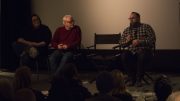“The sky is falling! The sky is falling!”
Chicken Little’s famous saying, in my opinion, is the message I receive every day when I watch the news, read the paper or listen to the radio. The mainstream media reports almost exclusively on stories that reinforce the same basic stereotypes — death, destruction, fear and terrorism — and we are forced to swallow these reoccurring themes without any critical commentary. If I had to base my understanding of the world in which I live solely upon the news media I am fed, I wouldn’t get much sleep at night. After all, if the dreaded H1N1 virus doesn’t get me, then it’s only a matter of time before some suicide bomber will.
Much like our political leaders, mainstream journalism focuses solely on the negative, interpreting current events with a glass-half-empty philosophy of the world. As British journalist Adam Curtis explains in his 2004 documentary The Power of Nightmares, in our day and age, “instead of delivering dreams, politicians now promise to protect us [ . . . ] from nightmares.”
And nightmares there are aplenty, both at home and abroad.
In terms of domestic news, the Canadian media has been infatuated with the H1N1 virus. And who can blame them? Yet instead of providing citizens with pertinent information on the topic, we are inundated with yellow journalism.
Even more ghastly, we are taught to believe that terrorism is happening continuously the world over. On Oct. 27, a bombing in Iraq kills 155 people, the most violent attack in that country in two years. The following day, 12 people, half of them UN staffers, are killed in Afghanistan; all the while a car bomb goes off in a market in Pakistan killing over 105 people. These are all tragic events, and in no way do I mean to trivialize them or the importance of catching those who perpetrate such crimes. But what I am concerned about is the frequency in which they’re reported in each medium of news we consume.
Think about it — when was the last time you heard any good news?
What positive news have we heard on the UN-sanctioned war in Afghanistan? Have people forgotten that state-sponsored terrorists under the command of Osama bin Laden attacked a member of NATO on Sept. 11, 2001? Why is it only the negatives — the death of Canadian soldiers, the failure of democracy and the growth of opium — that we always hear about? Why is Don Cherry the only journalist in our country reporting on positive news about the War in Afghanistan?
And what about terrorism? Again, I am in no way downplaying the importance of fighting to prevent terrorism the world over, but rather I am questioning why such stories are always at the start of the newscast or front pages of the paper. Based on the news we receive, one would guess terrorism is growing more prevalent by the day. Well, think again. The Human Security Report, an innovative project operating out of Simon Fraser University in Vancouver, reported in 2005 that since the end of the Cold War, global violence has declined drastically. Their latest update from 2008 summarizes that “a comprehensive review of the statistical data on global terrorism to the end of 2006 — domestic as well as international — [ . . . ] reveals that the global death toll from terrorism has fallen.” Put those findings in context of what you watch on the news each night and read in the paper each morning.
This leads to my point — the importance of history. By taking a step back and putting our current troubles into a historical perspective, all of a sudden things don’t seem so dire.
On the domestic level, the current hysteria over H1N1 may be justified, but it is important to place the deaths so far in perspective of the last great pandemic — the Spanish Flu. It’s estimated that between 50 and 100 million people died as a result of the Spanish Influenza, meaning that we have much catching up to do, considering that only 5,000 deaths so far have been attributed to H1N1.
And once again, what about terrorism? It too needs historical context. Take for example an event that happened 61 years ago this week. On Nov. 9, 1938, the Nazi regime in Germany launched their most flagrant and deadly pogrom against German Jews yet. Coined “Crystal Night” by historians in reference to the shattered windows of Jewish stores throughout Germany and Austria, this authentic example of state-sponsored terrorism puts current events in the Middle East and Southeast Asia into perspective. Crystal Night resulted in the murder of 99 Jews and the arrests of roughly 30,000 others, and was an unequivocal signal to the world that the Final Solution in Germany had begun.
That, unfortunately, is an example of state-sponsored terrorism at its most ruthless. Policymakers, political scientists and historians know how to differentiate said state-sponsored terrorism from local militant insurgencies and guerilla warfare; it’s too bad our media does not.
A former Manitoban contributor by the name of Marshall McLuhan is famous for saying that “the medium is the message,” meaning that how the media content is consumed by a person is as important as the media content itself. In our day and age, the medium — be it a newspaper, television broadcast or radio report — has created a message of cultural pessimism and negativity. It’s a worldview designed to intimidate people through fear into accepting news without question, and its focus is on delivering us nightmares instead of inspiring us to dream.
Until we question critically the newsmedia we are spoon-fed, we are no better than Chicken Little. Perhaps it’s time we all took a moment to look up towards the heavens to see if the sky is indeed falling.
Michael Silicz is an alumnus of the University of Manitoba.




